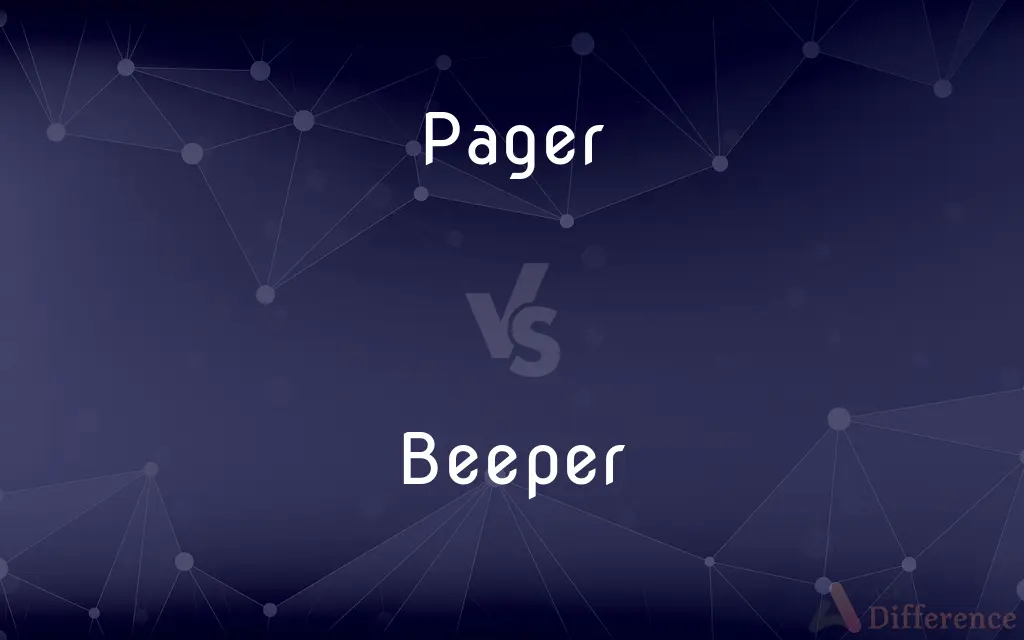Pager vs. Beeper — What's the Difference?
By Tayyaba Rehman & Maham Liaqat — Updated on April 29, 2024
A pager is a communication device that receives and displays numeric or text messages; a beeper is a type of pager that emits a beeping sound when a message is received.

Difference Between Pager and Beeper
Table of Contents
ADVERTISEMENT
Key Differences
Pagers are communication devices used primarily for sending and receiving alerts and messages, which can be either numeric or alphanumeric, depending on the device's capabilities. In contrast, beepers are simple pagers that notify the recipient with a beep or tone, usually indicating that they need to call a specific number.
Pagers allow for a more detailed form of communication because they can display text messages which provide direct information or instructions. On the other hand, beepers typically only inform the user that they need to make a call to receive further details, as they usually do not display message content beyond a callback number.
The use of pagers is common in environments where immediate communication is critical, such as in healthcare settings where staff need to be reachable at all times. Whereas, beepers were more popular in a past era when immediate, detailed communication was less critical, serving more as a signal to check in with a central communication point like an office or service desk.
Technological advances have seen pagers equipped with features like GPS, email reception, and encryption, enhancing their utility in complex communication networks. Conversely, beepers, due to their basic functionality, have largely been replaced by more advanced communication tools that offer comprehensive messaging capabilities.
While pagers are still in use today in specific sectors, beepers have seen a decline, primarily because modern smartphones and other communication devices can fulfill the same functions with added benefits like voice, text, and internet connectivity.
ADVERTISEMENT
Comparison Chart
Definition
A device that receives and displays messages in text or numeric form.
A simple pager that emits a beep or tone to signal an incoming message.
Communication Type
Numeric or alphanumeric messages.
Tone signal indicating a message or need to call back.
Primary Use
Detailed, critical communication in settings like hospitals.
Basic alerts for callback without specifics of the message.
Technological Features
May include GPS, email, encryption.
Limited to receiving signals and emitting tones.
Modern Relevance
Still used in niche areas where constant contact is necessary.
Largely obsolete due to advancements in mobile technology.
Compare with Definitions
Pager
Often used in professional environments for immediate communication.
Hospital staff use pagers to ensure timely patient care.
Beeper
Was primarily used before widespread mobile phone adoption.
In the 1990s, many professionals carried beepers.
Pager
Can display numeric or text messages.
His pager beeped with the room number of the emergency.
Beeper
Lacks the capability to display detailed messages.
Her beeper went off during the meeting, signaling an urgent call back to her desk.
Pager
Typically operates on a dedicated network.
Emergency services often rely on pager systems because they remain operational even when cell networks fail.
Beeper
Operates on a radio frequency system.
The beeper system in the restaurant alerts waitstaff when food is ready.
Pager
A device that receives and displays messages sent from a distant location.
The doctor carried a pager to receive emergency notifications from the hospital.
Beeper
A simple device that alerts the user by emitting a beep.
The volunteer firefighter carried a beeper to alert him to emergencies.
Pager
Remains relevant in areas with strict communication security needs.
Government agencies sometimes use encrypted pagers for secure communication.
Beeper
Limited function, generally indicating a callback is needed.
When his beeper sounded, he knew he had to find a phone to call the office.
Pager
{{|the telecommunications device}} A pager (also known as a beeper, bleeper or pocket bell) is a wireless telecommunications device that receives and displays alphanumeric or voice messages. One-way pagers can only receive messages, while response pagers and two-way pagers can also acknowledge, reply to and originate messages using an internal transmitter.Pagers operate as part of a paging system which includes one or more fixed transmitters (or in the case of response pagers and two-way pagers, one or more base stations), as well as a number of pagers carried by mobile users.
Beeper
One that beeps.
Pager
A simple wireless communications device that receives text messages or alerts.
Beeper
A pager that beeps or vibrates to alert the person carrying it that someone is trying to make contact by telephone.
Pager
(telecommunications) A wireless telecommunications device that receives text or voice messages.
Beeper
Something that makes a beeping sound.
Pager
(computing) A computer program running in a text terminal, used to view (but not modify) the contents of a text file moving down the file one line or one screen at a time.
Beeper
A simple computer speaker.
Pager
(in combination) Something (a document, book etc.) that has a specified number of pages.
Beeper
A pager wireless telecommunication device.
Pager
A small electronic communication device which signals when a telephone call has been received at a base station. Each such device receives radio signals from the base station specifically coded for the individual to whom it is registered; the signal given by the device to the registered user may be a beeping sound, indicating that the user should call the base station to receive a message; or it may display a telephone number to which the user may call directly to return the incoming call, or may display a short message. Such devices are small enough to carry in the pocket or pocketbook, or to clip onto a belt or other part of the clothing. Also called beeper.
Beeper
An electronic device that generates a series of beeps when the person carrying it is being paged
Pager
An electronic device that generates a series of beeps when the person carrying it is being paged
Common Curiosities
Are pagers still used today?
Yes, pagers are still used in certain professional settings like hospitals due to their reliability and dedicated network.
What are the advantages of using a pager over a smartphone in professional settings?
Pagers have the advantage of a dedicated network, which is often more reliable in emergency situations where cellular networks might fail.
Can beepers display text messages?
No, beepers typically do not display text messages; they only provide audible alerts to prompt a callback.
What is the primary difference between a pager and a beeper?
The primary difference is that a pager can display messages, whereas a beeper only alerts the user with a beep.
How do beepers work?
Beepers work by receiving a radio signal which then triggers an audible alert indicating that the user should check in or call back.
What type of messages can pagers receive?
Pagers can receive numeric and alphanumeric messages, allowing for more detailed communication.
Why might someone choose a beeper over a smartphone?
Historically, beepers were chosen over smartphones due to simplicity and cost, but today they are mostly obsolete.
What makes pagers reliable in emergencies?
Pagers are considered reliable in emergencies because they use dedicated frequencies less likely to be congested than cellular networks.
Why were beepers replaced by other technologies?
Beepers were replaced because they lacked the ability to convey detailed information and technologies like smartphones offered more comprehensive communication options.
Who typically uses pagers today?
Pagers are typically used by healthcare professionals, emergency services, and in other areas where secure and reliable communication is necessary.
Were beepers secure for sensitive communication?
Beepers were not particularly secure for sensitive communication because they lacked advanced encryption capabilities.
Is it possible to send a message to a pager from a phone?
Yes, it is possible to send messages to a pager from a phone, typically by dialing a pager number and entering a numeric message.
How does one respond to a message received on a beeper?
To respond to a beeper message, the recipient typically needs to call the originating number or a central office for more information.
What are the limitations of using beepers in modern communication?
The main limitations are their inability to provide detailed information and the prevalence of more versatile technologies like smartphones.
Can pagers be used internationally?
Pagers can be used internationally, but they require a network that supports pager services, which may not be available everywhere.
Share Your Discovery

Previous Comparison
Flux vs. Fluence
Next Comparison
Villa vs. VilaAuthor Spotlight
Written by
Tayyaba RehmanTayyaba Rehman is a distinguished writer, currently serving as a primary contributor to askdifference.com. As a researcher in semantics and etymology, Tayyaba's passion for the complexity of languages and their distinctions has found a perfect home on the platform. Tayyaba delves into the intricacies of language, distinguishing between commonly confused words and phrases, thereby providing clarity for readers worldwide.
Co-written by
Maham Liaqat















































